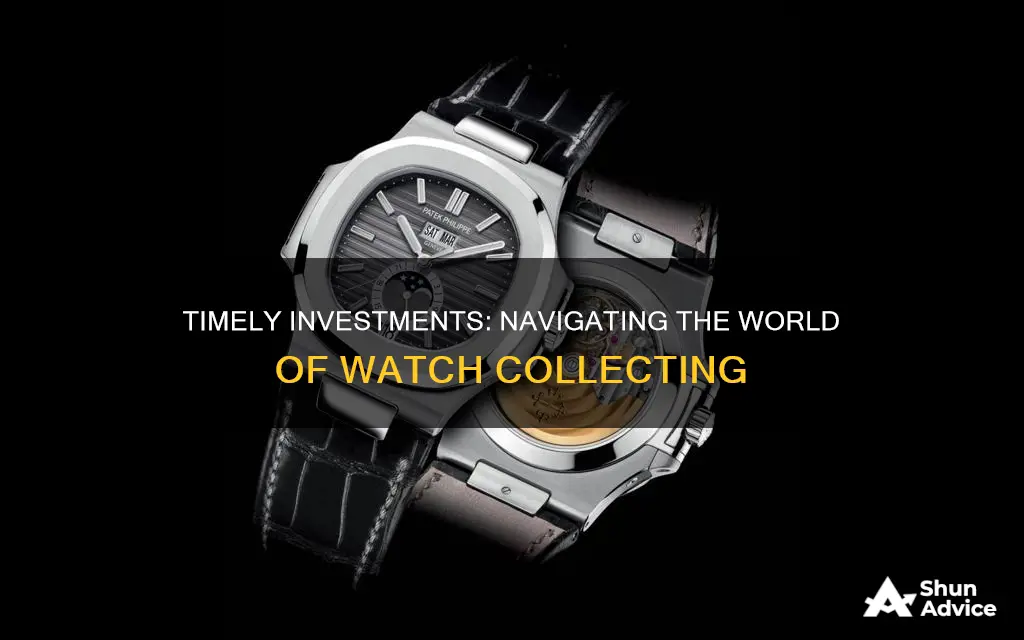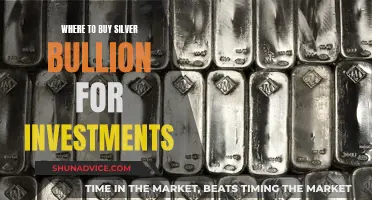
Investing in watches is a controversial topic. While some people may view it as a quick way to make money, others may be passionate about the art of watchmaking and the emotional investment of a timepiece. Nevertheless, luxury watches can be a valuable investment, with their value increasing drastically over time. Here are some factors to consider when buying a watch as an investment:
- Scarcity: Limited edition watches or those from small independent brands tend to be good investment pieces as their demand is likely to outpace supply, increasing their value.
- Condition: A watch in good condition will always be more desirable. While a little patina is acceptable, extensive damage or repairs can decrease its value.
- Authenticity: It is crucial to ensure the watch is original and authentic, especially when dealing with modern timepieces, to avoid counterfeits.
- Brand: Some brands like Rolex, Patek Philippe, Audemars Piguet, and Omega have a proven track record of successful investments and are highly coveted by collectors.
- Popularity: Following trends and predicting future demand can help identify potential investments. For example, the Rolex Daytona, initially unpopular in the 60s and 70s, gained popularity after being worn by actor and racing driver Paul Newman.
- Supply and Demand: Like any other asset, a watch's price depends on supply and demand. A watch with high demand and limited supply will result in a premium price.
| Characteristics | Values |
|---|---|
| Scarcity | Limited editions, small independent brands, vintage models that were initially unpopular |
| Condition | Crisp and sharp case, no rounded edges, no cracks on the dial, no signs of rust or pitting on the movement |
| Authenticity | Original and authentic, not a counterfeit, no extensive work done |
| Brand | Rolex, Patek Philippe, Audemars Piguet, Omega, Tudor, Vacheron Constantin |
| Type | Sports watches, stainless steel watches |
| Popularity | Trending, popular among collectors |
| Discontinuation | Popular models being discontinued |
| Resale value | High resale value, sold at a premium |
What You'll Learn

Scarcity and demand
Luxury watch manufacturers produce a limited number of pieces, which drives prices higher in secondary markets. The fewer examples of a particular watch model, the more likely it is that demand will outpace supply, and the value will increase. Watches made in small quantities, such as limited editions or timepieces from small independent brands, are good candidates for investment.
The law of supply and demand explains how changes in a product's market price relate to its availability and desirability. When demand for a commodity is higher than the supply, this leads to scarcity and higher prices. This is often the case with luxury watches, where differentiation and uniqueness are key features.
The price of a watch, like any other good, depends on supply and demand and can vary due to numerous factors. For example, if a brand discontinues a popular model, the price on the second-hand market may increase. Additionally, small details, such as different dials, cases, and insert variations, can make a significant difference to collectors, and these can be collectible in the future.
Some specific brands, such as Rolex, Omega, Patek Philippe, Audemars Piguet, and Tudor, have proven to be successful as watch investments. Certain models from these brands, such as the Rolex Daytona, Patek Philippe Nautilus, Audemars Piguet Royal Oak, and Tudor Black Bay Fifty-Eight, are highly sought-after and sold at a premium.
The value of a watch can also drop, just as a stock price can plummet or house prices can suddenly decrease. A recession, for example, may force watch owners to sell their watches, increasing supply and causing prices to drop.
In summary, when considering a watch as an investment, it is important to look for watches with limited availability that are in high demand. Scarcity and demand are key factors in driving up the value of luxury watches over time.
Invest Wisely: Property Strategies
You may want to see also

Condition and authenticity
When investing in a watch, it is crucial to pay close attention to its condition and authenticity. Here are some detailed guidelines to help you navigate this process:
Condition:
The condition of a watch is of utmost importance when investing. A watch in poor condition, even if it is rare, may not be desirable to potential buyers. When examining a used or vintage watch, look for signs of excessive wear or damage. Check if the case is crisp and sharp, or if it has rounded edges. Inspect the dial for any cracks and the movement for signs of rust or pitting. Compare the watch to other verified examples in good condition to establish a baseline. Remember that a little patina can be desirable, adding character to the timepiece.
Authenticity:
Ensuring the authenticity of the watch is critical to a successful investment. Counterfeit watches are prevalent, and it is essential to verify that the watch is original or, in the case of modern timepieces, not a counterfeit. Educate yourself about the specific watch model you are interested in, including its unique characteristics and variations. Find a reputable dealer who can help verify the watch's service history and provenance. The more you know about the watch's history and previous owners, the better. Ask for a certificate of authenticity and check that the model and serial numbers match the watch. Additionally, inquire about any aftermarket parts added to the watch and have diamonds or other precious stones tested for authenticity.
Service History and Refurbishment:
It is important to distinguish between a watch in exceptional condition due to extensive refurbishment and one that is genuinely new old stock. A watch may have had various parts replaced, such as the dial, crystal, bezel, or bracelet, or undergone processes like laser welding on the lugs. While a replacement part does not necessarily diminish the investment potential, honesty and disclosure are crucial. Know what has been replaced, and ensure the watch is valued accordingly.
Boxes, Papers, and Accessories:
While not always necessary for personal use, having the original box, paperwork, and accessories can significantly impact the resale value of a watch. Collectors highly value complete sets, so retaining all the items that came with the watch when it was new can command a higher price in the future.
In summary, when investing in a watch, thoroughly inspect its condition, verify its authenticity, and ensure you have a complete understanding of its service history and any replacements or refurbishments. By following these guidelines, you can make a more informed decision and increase the likelihood of a successful investment.
Mortgage Freedom or Monthly Investment: The Great Financial Debate
You may want to see also

Brand and model
When it comes to investing in watches, brand and model are key considerations. While there are no guarantees, certain brands and models have proven to be more successful investments than others. Here are some factors to consider when choosing a watch brand and model for investment purposes:
Brand Reputation and Performance:
- Rolex: Rolex is widely regarded as the king of luxury watch investments. The brand is known for its high quality, reliability, and ability to hold its value. Rolex sports models, such as the Submariner and the GMT-Master, are extremely desirable and often have long waiting lists. The Rolex Daytona, in particular, has a strong track record of appreciation.
- Patek Philippe: Patek Philippe is synonymous with luxury and prestige. Their watches are highly sought-after by collectors and often command a premium on the second-hand market. The Nautilus and the Aquanaut are two of their popular models.
- Audemars Piguet: Audemars Piguet is valued for its Swiss luxury and precision. Their Royal Oak model is highly coveted and has seen significant appreciation over time.
- Omega: Omega is another well-known brand, with the Speedmaster "Moonwatch" being a popular investment choice. The Speedmaster series has a historical connection to the Apollo 11 astronauts and offers a range of styles.
- Other reputable brands: While the above brands are often mentioned, other reputable brands that have shown strong investment potential include Vacheron Constantin, Tudor, and F.P. Journe.
Model Scarcity and Demand:
When considering a specific model, it's important to look at its scarcity and demand. Limited editions, timepieces from small independent brands, or vintage models that were initially unpopular can be good investment choices. For example, the original Audemars Piguet Royal Oak was initially unpopular but has since become highly sought-after.
Model Discontinuation:
Keep an eye out for brands discontinuing popular models, as this can cause a surge in prices on the second-hand market. For example, when Rolex discontinued the GMT Master II reference 116710LN in 2019, its price immediately increased.
Model Authenticity and Condition:
It's crucial to ensure the authenticity of the watch and verify that it's not a counterfeit. Additionally, the condition of the watch is vital. A well-maintained watch with minimal repairs and servicing by a skilled watchmaker is ideal.
Model Popularity and Trends:
While it can be challenging to spot new trends, keeping an eye on online trends and celebrity preferences can provide insights. For example, the Rolex Submariner's popularity has resulted in high demand and premium prices on the second-hand market.
Remember, investing in watches involves careful consideration of various factors, and it's always a good idea to buy what you love and would be proud to wear.
Planning for Retirement: Navigating the Investment Scale-Back
You may want to see also

Buy new or second-hand
When buying a watch as an investment, you can choose to buy it new or second-hand. Here are some things to consider for both options:
Buying New
If you want to buy a new watch as an investment, it is advisable to purchase from certified dealers to minimise the risk of counterfeits. However, this option may require patience as many manufacturers limit the supply of their exclusive watches, resulting in waiting lists for certain models. For example, the waiting period for popular Rolex models can be several years. Additionally, when buying new, you have full control over the choice of watch and can compare prices from different authorised dealers or auction websites/marketplaces.
Buying Second-Hand
The pre-owned watch market has been steadily growing, and it offers some advantages over buying new. One advantage is the immediate availability of watches, including rare, discontinued models that are no longer manufactured. Second-hand watches can be purchased from auction houses, online platforms, or established watch dealers. When buying second-hand, it is crucial to exercise caution and ensure the watch's authenticity. Look for original documentation, such as the user manual, certificate of authenticity, warranty card, and even the original purchase receipt and service history. Additionally, inspect the watch for any signs of wear, tear, or over-polishing, as this can impact its value.
Whether you choose to buy new or second-hand, it is important to consider factors such as the watch's condition, rarity, brand, and market demand, as these will influence its profitability as an investment.
Investors: Money Masters or Risk-Takers?
You may want to see also

Resale and insurance
When it comes to investing in watches, resale value is a key consideration. The ability to resell your watch at a profit is dependent on various factors, including the brand, model, condition, authenticity, and market demand. Here are some tips to maximise your watch's resale value and protect your investment:
- Condition and Authenticity: Keep your watch in pristine condition by regularly cleaning it with a soft, dry cloth and avoiding exposure to extreme temperatures. Ensure any servicing is performed by a skilled watchmaker, and store it in a cool, dry place when not in use.
- Original Packaging and Accessories: The original box, paperwork, and accessories can significantly impact the resale value. Collectors prefer complete sets, so keep all the items that came with your watch, including the original receipt, certificate of authenticity, and any aftermarket additions.
- Research and Timing: Follow online trends and keep an eye on the specific reference and market value of your watch. Generally, if the value is rising, it's a good time to sell. However, predicting trends can be challenging, so research popular models and small details that collectors value.
- Insurance: Immediately insure your watch with a specialty jewellery insurance company. Basic homeowners insurance may not cover your watch adequately. Look for insurance that covers worldwide loss, theft, damage, and mysterious disappearance, with affordable monthly payment options.
By following these guidelines, you can help ensure that your watch retains or increases its value over time, making it a sound investment piece. Remember, investing in watches may not always guarantee a profit, but with the right choices and care, you can increase the chances of a favourable outcome.
Qapital Invest Launch: When Will Users Get to Experience This New Feature?
You may want to see also
Frequently asked questions
Watches can be a good investment, but it depends on a variety of factors, such as the brand, materials used, type of watch, condition, rarity, and current market demand. Generally, luxury watches from brands such as Rolex, Patek Philippe, and Audemars Piguet tend to increase in value over time.
Certain watch models that have increased in value over time include the Rolex Submariner, Rolex Daytona, Patek Philippe Nautilus, and Audemars Piguet Royal Oak.
There are a few options for purchasing a luxury watch: directly from the manufacturer, from an authorized dealer, or on the secondary market. Buying directly from the manufacturer guarantees authenticity and often includes the original box and paperwork, which can increase the resale value. Authorized dealers may offer new or pre-owned watches and can provide authentication and additional services. The secondary market offers pre-owned or vintage watches at potentially lower prices but may come with risks regarding authenticity and condition.
When buying a watch as an investment, consider the brand, model, and condition. Look for watches in excellent condition, with limited editions or models from small independent brands that have low production quantities. Additionally, ensure the watch is original and authentic, especially for modern timepieces where counterfeits may exist.
It is recommended to get insurance coverage specifically for your luxury watch, as homeowners insurance may not provide adequate coverage. To maintain the best resale value, clean your watch regularly with a soft, dry cloth, and avoid harsh chemicals or extreme temperatures. Send your watch for professional servicing every five years to ensure optimal condition.







